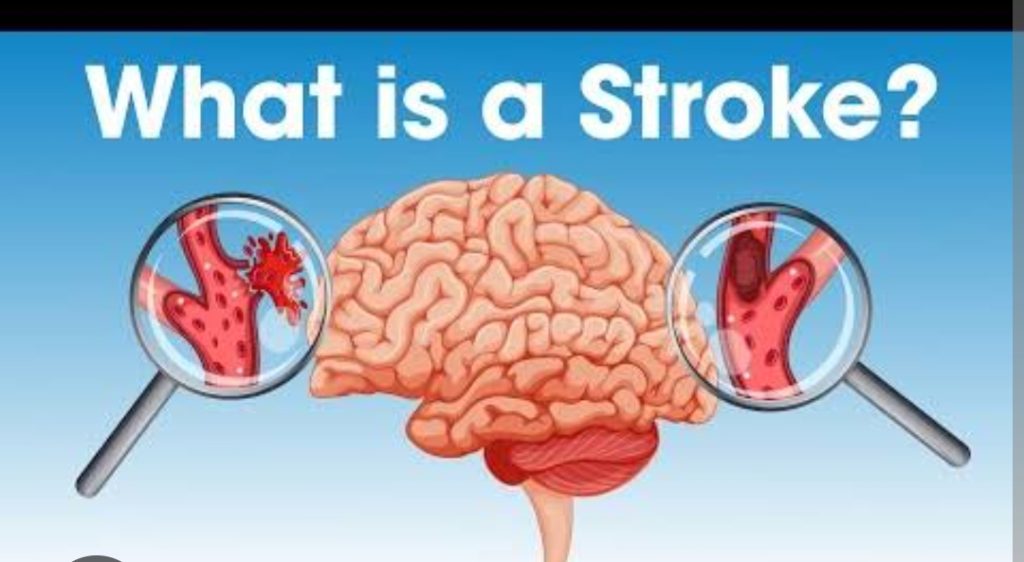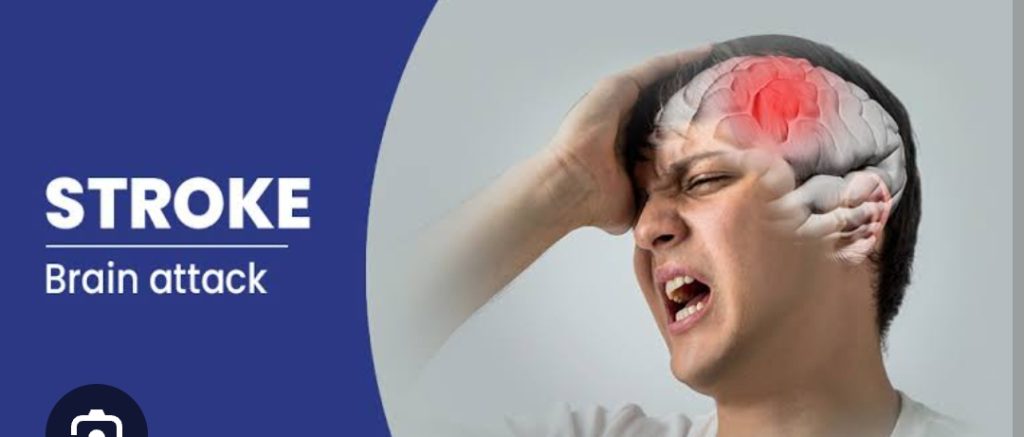
STROKE
Stroke / Cerebral vascular accidents (CVAs), also known as “brain attacks,” are one of the most common causes of death and disability in the United States.
CVA (stroke) can cause paralysis, speech loss, or vision and hearing. They are one of the leading causes of death and disability in the United States, and are also a leading cause of long-term disability among adults1. This can occur at any age but is most common in people older than sixty-five.
When the brain is oxygen-deprived, a stroke or CVA causes long-term, irreversible damage. The most common causes of this are a blood clot, arteriosclerosis, or a damaged blood vessel (aneurysm).
Strokes can be classified as either TIAs (transient ischaemic attacks) or CVAs (cerebral vascular accidents). While TIAs restrict oxygen temporarily and resolve on their own, CVAs are more severe and result from a sustained lack of oxygen.
The nurse must be aware that the client is likely to be confused when being evaluated, especially in the early phases of recovery. Additionally, keep in mind that they can have difficulties speaking or understanding language, which could prevent them from being able to communicate successfully.
A stroke happens when a brain blood vessel bursts and starts bleeding. Blood flow to a portion of the brain is cut off by this hemorrhage, which may result in long-term harm.
The body will naturally attempt to stop the bleeding by forming a clot around the affected location, but doing so may also block the blood supply to other areas of the brain. Thrombolytic drugs aid in dissolving these clots so that additional treatments or surgical techniques can be used to remove them.
Treatment for CVA depends on the severity and location in the brain. For example, some strokes require only treatment with medications, while others may require surgery or procedures to remove blood clots from narrowed arteries in the neck (carotid endarterectomy).
Pathophysiology of Stroke / CVA
Blood supply to the brain? The blood supply to the brain comes for the carotid and vertebral arteries, which then branch into other arteries that feed the brain. If any of these areas of the artery become blocked or burst open it decreases the blood supply to the brain cells. Brain cells are very sensitive and within 5 minutes these cells start to become damaged, and the damage can become IRREVERSIBLE.
A stroke is defined as an abrupt neurological outburst caused by impaired perfusion (the passage of blood) through the blood vessels to the brain. The blood flow to the brain is managed by two internal carotids and two vertebral arteries (the circle of Willis). There are two types of strokes: TIA (transient ischaemic attack) and CVA (cerebral vascular accident). TIA temporarily limits oxygen and resolves on its own, and CVA is more permanent from a long-term lack of oxygen.
Cerebral Vascular Accident (CVA)
Because the blood supply to the brain is interrupted, CVA is brought on by a lack of oxygen. This loss of oxygen causes long-term damage to clients. An aneurysm (a blood artery that bursts inside the brain) can also result from a stroke.
Ischemic stroke is caused by deficient blood and oxygen supply to the brain, known as embolic or thrombotic stroke. Ischemic (most common): due to a blood clot within a blood vessel or stenosis of an artery that feeds the brain tissue. This limits the blood that can reach the brain cells. This type of stroke can happen due to:
Embolism: where a clot has left a part of the body (example the heart: this can happen due to a heart valve problem or atrial fibrillation). The clot develops in the heart and travels to the brain, which stops blood flow.
Thrombosis: Clot forms within the artery wall within the neck or brain. This is seen in patients with hyperlipidemia or atherosclerosis
Hemorrhagic stroke is caused by bleeding or leaky blood vessels. This typically results from a blood clot, narrowed blood vessels (arteriosclerosis), or a ruptured blood vessel (aneurysm). This results in increased intracranial pressure (ICP).
Hemorrhagic: This occurs when there is bleeding in the brain due to a break in a blood vessel. Therefore, no blood will perfuse to the brain cells. In addition, this can lead to excessive swelling from the leakage of blood in the brain. Causes of this type of stroke includes: rupture of a brain aneurysm, uncontrolled hypertension, or aging blood vessels (older age).
Transient Ischaemic Attack (TIA)
TIA is a constriction of the blood vessels, which results in less oxygen reaching the brain and other body parts. Lack of oxygen can happen suddenly – and TIAs can come and go.
TIA (transient ischemic attack) also called a mini-stroke. This is where signs and symptoms of a stroke occurs but last only a few minutes to hours and resolves. It is a warning signs an impending stroke may occur. If this occurs the patient needs to seek treatment.
Transient TIAs have a short time frame, and Ischemic TIAs result from low oxygen.
Risk Factors and Causes Of stroke
Hypertension (defined as systolic blood pressure over 140) is the number one most tested and important vital to monitor for stroke.
Other risk factors and causes include:
Smoking– scars the blood vessels making them weak
Hyperlipidemia- (high cholesterol) narrows the blood vessels.
Atherosclerosis
Physical inactivity
Previous TIA
Elevated blood sugar (diabetes mellitus)
Aneurysm (brain)
Increased risk from atrial fibrillation and heart valve malfunctions
Stroke Signs and Symptoms
Signs and symptoms of a stroke occur when damage occurs to an area in one hemisphere. This is known as hemispheric dominance. The left and right hemispheres of the brain are responsible for different tasks. Manifestations will depend on which hemisphere is affected and how much damage occurred.
Signs of Impending Stroke
The signs of an impending stroke can be difficult to assess. A client experiencing a stroke can be confused, disoriented, and unable to think clearly with trouble finding words:
Difficulty walking or maintaining balance
Face and arms drooping on one side (hemiplegia)
Double or blurry vision in one or both eyes
Sudden nausea
Unusual pain in the upper back or jaw
Slurred speech
Left Hemisphere Stroke Symptoms
Left hemisphere strokes affect the side of the brain controlling functions like language and reasoning. Left hemisphere stroke clients experience:
Right-sided weakness or paralysis and sensory impairment.
Problems with speech and understanding language (aphasia)
Visual problems, including the inability to see the right visual field of each eye.
Impaired ability to do math or to organize, reason, and analyze items.
The client will most likely need rehabilitation after initial treatment.
Right Hemisphere Stroke Symptoms
The right hemisphere of the brain controls emotions, facial recognition, and nonverbal communication. As a result, clients with right hemisphere strokes are impacted by how they interact with others, and how well they can express themselves.
When a stroke damages the right hemisphere, clients may experience a range of symptoms that are quite different from those caused by damage to the left hemisphere, including:
Inability to make decisions
Difficulty speaking (aphasia) or difficulty writing (agraphia)
Lack of empathy for others
Vision problems, including problems seeing from the left side of each eye with Inability to recognize faces
Difficulty with spatial reasoning
Muscle weakness on the left side of the body.
Hearing problems.
Sensory changes on the left side of the body.
Right hemisphere strokes can be misdiagnosed as migraine headaches because they cause visual disturbances (migraine aura).
Stroke Assessment
A thorough history and assessment will help the health care team to determine what type of stroke the client may have experienced along with the severity of symptoms
The first step in caring for a client who has had a stroke is a history and physical assessment. To determine where they are experiencing their symptoms.
The history includes interviewing the client with questions about the onset of symptoms.
As a nurse, you’ll assess the level of consciousness or confusion.
Signs of paralysis or weakness on one side of the body
Slurred speech
Numbness or tingling in the arms and legs
Confusion
Trouble seeing out of one eye (or both).
Tingling sensations
Vision problems
Difficulty speaking or swallowing
Nursing Interventions for Stroke
Avoid Administering sedation meds before meals
Avoid Completing tasks for the client (to promote independence)
Avoid Speaking loudly to clients
Perform Transfers with a transfer belt (and always transfer toward the stronger side)
Perform Frequent neurological assessments
Provide Puree diet (NOT solid foods)
Provide Patience (especially when asking questions)
Patient positioning (High Fowler’s – upright)
Implement these seizure precautions:
Strict bed rest
No Blood thinners
NO Aspirin & Clopidogrel
NO Heparin & Enoxaparin
NO Warfarin
NO Thrombolytics
Limit any activity that may increase ICP
Administer PRN stool softeners daily to prevent straining and bearing down during bowel movements.
Medication for Ischemic Strokes:
tPA (tissue plasminogen activator): for ischemia strokes ONLY not hemorrhagic!
How does it work? It dissolves the clot within the blood vessel by activating the protein that causes fibrinolysis.
REMEMBER: It must be given within 3 hours from the onset of stroke symptoms. It can be given 3 to 4.5 hours after onset IF strict criteria is met.
To receive tPA the patient should have a:
CT of head that is NEGATIVE for hemorrhage
Labs within normal limits (glucose, INR, platelets)
BP needs to be controlled SBP <185 and DBP <110
Glucose controlled (increases rise of hemorrhage)
Not receiving heparin or other types of anticoagulants.
Nurse’s Role:
Monitor for BLEEDING
Neuro checks around the clock
Blood pressure medication if needed for hypertension, vital signs, labs, glucose.
Preventing injury (bedrest)
Avoid unnecessary venipunctures,
Avoid IM injections,
Patients may need ICU admission to be closely monitored.
Important Stroke Terms:
Remember these terms because exams love to ask you about them.
Aphasia: unable to speak (comprehending or producing it)
Receptive Aphasia: unable to comprehend speech (Wernicke’s area)
Expressive Aphasia: comprehends speech but can’t respond back with the correct words, if at all (Broca’s area)
Mixed Aphasia: combination of the two types of aphasia.
Global Aphasia: complete inability to understand speech or produce it.
Dysarthria: unable to hear speech clearly due to weak muscles (hard to understand the patient’s speech….it may be slurred)
Apraxia: can’t perform voluntarily movements (winking/moving arm to scratch an itch) even though muscles function is normal.
Agraphia: loss the ability to write
Alexia: loss the ability to read…doesn’t understand or recognize the words
Agnosia: doesn’t understand sensations or recognize known objects or people
Dysphagia: issues swallowing (weak muscles)
Hemianopia: limited vision in half of the visual field
Hemiparesis: weakness on one side of the body.
National Stroke Association recommends using the mnemonic F.A.S.T. to help assess for signs and symptoms quickly.
“FAST”
Face: drooping or uneven smile
Arm: numbness, weakness, drift (raise both arms)
Speech: can’t repeat a phrase, slurred speech
Time: to call rapid response and note the time


